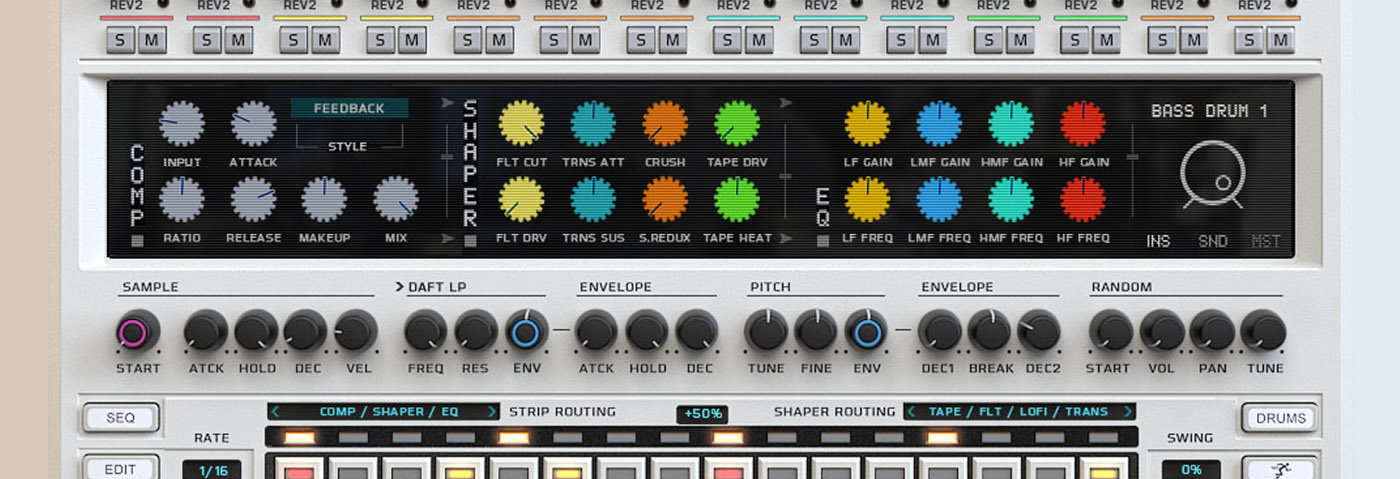Wave Alchemy’s latest instrument replicates some of the most sought-after vintage drum machines. Jonny Strinati puts it to the test.
Wave Alchemy have built an esteemed reputation over the years, consistently delivering top quality virtual instruments and outstanding sample libraries. Their ability to painstakingly recreate the sound of iconic drum machines, presented in well designed Kontakt instruments, has been their speciality. Revolution is no exception, featuring 14 of the world’s most sought-after vintage drum machines, a suite of effects, a multi-track sequencer and more.
The drum machines are presented within a 14-voice mixer, allowing users to mix and match any combination in order to build their own modular setup. The names of the modules on offer give major clues as to the sources of the samples from various Roland, Linn, Oberheim, E-mu and Sequential Circuits units: RV-78, RV-8000, RV-808, RV-909, RV-606, RVDRUM, RVDX, RVULATOR, RVTRAKS, RVSP12, RV-707, RV-505 and RVBOY. And if the names aren’t a dead giveaway, the GUIs for each module will be.
The mixer features individual volume, pan, delay send, reverb send, solo and mute controls for each sound, but more importantly you can also click on the title button at the top of the mixer to edit or swap out the module. I instantly warmed to the idea of mixing and matching modules in this way, combining an 808 bass drum with 909 toms, a LinnDrum clap and 606 hi-hats. Hitting on an original idea in this oversaturated world of plugins is no easy feat, but I think Wave Alchemy have something unique with Revolution. Maybe this idea could be expanded in a future update, with more modules being added, or even offer a completely modular option, where you can pick and choose how many drum voices and modules or effects you add in.
The editing controls on each module are impressive, most notably the Character knob. This differs depending on the module, but options include Analog, Digital, Tape, SP1200, Mastered and Biscuit, to name a few. Analog (and most of the others) creates a round robin signal path, with the samples constantly alternating, each hit slightly different from the last, just as you would experience using the hardware. Along with this, other character styles were created by tracking through various samplers, Studer tape machines, high-end boutique hardware and valve processors. There’s even a Digital option for machine gun-style triggering.
A choice of 20 different filters types can be applied to any drum voice, featuring a range of low-pass, band-pass and high-pass options, along with envelope and pitch controls. On the far right of this section we get some randomisation controls for sample start, volume, pan and tune, providing further options to introduce subtle inconsistencies in the sample playback.
At the bottom of the Revolution interface you’ll find a Roland x0x-style step sequencer with rate control, transport, swing and chase controls. Programming patterns in this way is extremely fun and intuitive and offers that free-flowing, live jam approach to laying down classic drum machine grooves, usually stumbling upon happy accidents. Clicking on the SEQ button reveals the Global Sequencer page, where you can apply more precise and dynamic control to various aspects of your patterns. As well as copying, duplicating and clearing patterns, you can also change the sequence length and apply ‘slop’ for humanised playback – great for drum flams or stacked hits. There are some useful shortcuts for quick and creative programming, along with some handy presets to get you going, but the only thing I missed from the global sequencer page is an undo option; it’s easy to clear complete patterns by accident, but there’s no way to reverse that action.
Rounding out the sound design options, you’ll also find a set of insert, send and master effects with a mixture of compression, wave shaping (tape emulation, bitcrushing and filter drive) and EQ options. The send effects features two syncable delays, while the two convolution reverbs offer 160 different impulse responses, taken with different mics and using different room sizes.
The attention to detail with Revolution is quite immense, from the round robin playback through to the impulses and the various sonic options; apparently two different 808s were sampled in order to offer a wider range of tones, while 20,000 samples were taken of the 909 bass drum alone. For me, Wave Alchemy have really delivered with a virtual instrument that captures the inherent behaviour of analogue equipment. The drum modules really do sound superb, and all the subtle nuances of these influential machines are present, from the sound to the visual design. There’s deep control offered in a way that’s simple, intuitive and a pleasure to work with. Revolution isn’t cheap, but this is a serious instrument. If you’re a big fan of classic drum machines, but also enjoy adding your own flair when working with those sounds, then Revolution is a pretty much an essential purchase.
The Verdict
Price: £149.95
Purchase: Wave Alchemy
The Final Word
Revolution isn't cheap, but this is a serious instrument.

06.35 PM
So it must be a horrible product then?